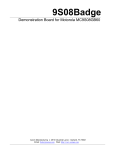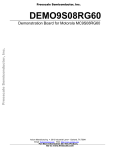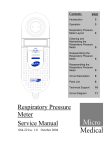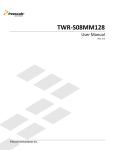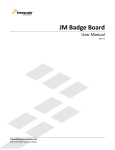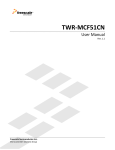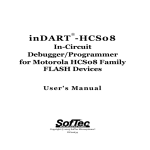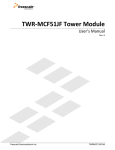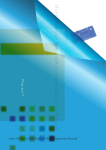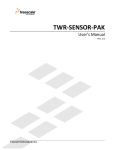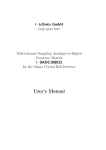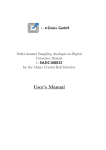Download M68DEMO908GB60
Transcript
M68DEMO908GB60 Demonstration Board for Freescale MC9S08GB60 Includes DEMO9S08GB60-SP version ! Axiom Manufacturing • 2813 Industrial Lane • Garland, TX 75041 Email: [email protected] Web: http://www.axman.com ! M 6 8 D E M O 9 0 8 G B 6 0 0 1 / 1 2 / 0 5 CONTENTS CAUTIONARY NOTES ...........................................................................................................................................................3 TERMINOLOGY ......................................................................................................................................................................3 FEATURES................................................................................................................................................................................4 GETTING STARTED...............................................................................................................................................................5 REFERENCE DOCUMENTATION .................................................................................................................................................5 M68DEMO908GB60 STARTUP............................................................................................................................................6 What Do the Demo Programs Do?......................................................................................................................................6 Applying the Demo Programs .............................................................................................................................................7 TABLE1: Demo Program Option Selections .......................................................................................................................8 Selecting the Demo Programs .............................................................................................................................................8 TABLE 2: Demo Program Selection....................................................................................................................................8 DEBUG MONITOR OPERATION .........................................................................................................................................9 MONITOR MEMORY MAP: .................................................................................................................................................9 M68DEMO908GB60 BOARD OPERATION.......................................................................................................................10 POWER SUPPLY .................................................................................................................................................................10 ON_OFF Switch ................................................................................................................................................................10 Batteries.............................................................................................................................................................................10 PWR - Power Jack .............................................................................................................................................................10 PWR_SEL Option ..............................................................................................................................................................11 Y1 CRYSTAL ..........................................................................................................................................................................11 R3 (XPG2) and R4 (XPG1) Options ..................................................................................................................................11 SCI1 AND SCI2 PORTS ...........................................................................................................................................................11 COM_EN ...........................................................................................................................................................................12 SCI1 and SCI2 Connection................................................................................................................................................12 LED 1-5 INDICATORS.............................................................................................................................................................12 VRH_SEL AND 1.8V REFERENCE .........................................................................................................................................13 VRH_SEL...........................................................................................................................................................................13 JP2 – VREFL .....................................................................................................................................................................13 SW1–SW4 PUSH SWITCHES...................................................................................................................................................13 JP1 – PWM / DAC ................................................................................................................................................................14 M68DEMO908GB60 I/O PORT CONNECTORS ...............................................................................................................14 ANALOG AND PTB I/O PORT CONNECTOR ..........................................................................................................................14 MCU I/O PORT CONNECTOR..................................................................................................................................................15 DEBUG PORT ......................................................................................................................................................................15 2 M 6 8 D E M O 9 0 8 G B 6 0 0 1 / 1 2 / 0 5 Cautionary Notes 1) Electrostatic Discharge (ESD) prevention measures should be applied whenever handling this product. ESD damage is not a warranty repair item. 2) Axiom Manufacturing does not assume any liability arising out of the application or use of any product or circuit described herein; neither does it convey any license under patent rights or the rights of others. 3) EMC Information on the M68DEMO908GB60 board: a) This product as shipped from the factory with associated power supplies and cables, has been verified to meet with requirements of CE and the FCC as a CLASS A product. b) This product is designed and intended for use as a development platform for hardware or software in an educational or professional laboratory. c) In a domestic environment this product may cause radio interference in which case the user may be required to take adequate prevention measures. d) Attaching additional wiring to this product or modifying the products operation from the factory default as shipped may effect its performance and also cause interference with other apparatus in the immediate vicinity. If such interference is detected, suitable mitigating measures should be taken. Terminology This development board applies option selection jumpers. Terminology for application of the option jumpers is as follows: Jumper on, in, or installed = jumper is a plastic shunt that fits across 2 pins and the shunt is installed so that the 2 pins are connected with the shunt. Jumper off, out, or idle = jumper or shunt is installed so that only 1 pin holds the shunt, no 2 pins are connected, or jumper is removed. It is recommended that the jumpers be idled by installing on 1 pin so they will not be lost. This development board applies hard wired option selection for JP2 (VREFL). This option selection applies a circuit trace between the option pads to complete a default connection. This type connection places an equivalent Jumper Installed type option. The circuit trace between the option pads may be cut with a razor blade or similar type knife to isolate the default connection provided. Applying the default connection again can be performed by installing the option post pins and shunt jumper, or by applying a wire between the option pads. 3 M 6 8 D E M O 9 0 8 G B 6 0 0 1 / 1 2 / 0 5 FEATURES The M68DEMO908GB60 is an evaluation or demonstration board for the M9S08GB60 microcontroller. Development of applications is quick and easy with the included DB9 serial cable, sample software tools, examples, and debug monitor. The prototyping area provides space to apply the MCU I/O to your needs. The DEBUG port is provided for development tool application and is compatible with HCS08 BDM interface cables and software. Features: ♦ M9S08GB60 CPU * 60K Byte Flash * 4K Bytes Ram * 56 I/O lines (64 pins) * 5 channel TPM 2 Timer * 3 channel TPM 1 Timer * 8 Channel 10 BIT A/D * SPI and IIC Serial Ports * 2 x SCI Serial Ports * Key Board Wake-up Ports * BDM DEBUG Port * Clock generator w/ FLL * up to 40Mhz operation ♦ 32Khz Crystal ♦ Regulated +3.3V power supply ♦ SCI1 Serial Port w/ RS232 DB9-S Connector * SCI1 Serial Port ♦ SCI2 Serial Port w/ RS232 DB9-S Connector * SCI1 Serial Port ♦ Power ON/OFF switch ♦ User Components Provided * 5 LED Indicators (PTF0-3, PTD0) * 4 Push Switches (PTA4-7) * Digital to Analog (PTD2, PTB1) * 1.8Volt reference ♦ MCU I/O Port connector provides all digital I/O ♦ Analog or PTB I/O Port connector provides analog inputs or PTB I/O ♦ Prototype Area ♦ 2 x AA Battery Holder ♦ Supplied with DB9 Serial Cable, Documentation (CD), Manual, and Batteries or Wall plug type power supply. Specifications: Board Size 4” x 4.5” Power Input: +6 to +12VDC, 9VDC typical Current Consumption: 30ma @ 9VDC input 4 M68DEMO908GB60 M 6 8 D E M O 9 0 8 G B 6 0 0 1 / 1 2 / 0 5 GETTING STARTED The M68DEMO908GB60 single board computer is a fully assembled, fully functional development board for the Freescale MC9S08GB60 microcontroller. Provided with 2 AA batteries or wall plug power supply, and serial cable. Support software for this development board is provided for Windows 95/98/NT/2000/XP operating systems. Development board users should also be familiar with the hardware and software operation of the target HCS08 device, refer to the provided Freescale User Manual for the device and the HCS08 Reference Manual for details. The demonstration board purpose is to promote the features of the 9S08GB60 device or to assist the user in quickly developing an application with a known working environment. Users should be familiar with memory mapping, memory types, and embedded software design for the quickest successful application development. Application development may be performed by applying the embedded serial interface monitor, or by applying a compatible HCS08 BDM cable with supporting host software. The monitor provides an effective and low cost debug method. Note that when a BDM cable is applied to the DEBUG Port for debugging, the BDM pod should be powered from an external supply. The serial debug monitor is provided in the development board HCS08 device internal flash memory and applies some HCS08 resources for operation. See the AN2140 application note from Freescale for complete details. User applications operated under monitor control may be configured for dedicated operation by applying the User Reset Vector (0xFBFE/F) and programming the application into the device flash. The monitor will remain in protected flash memory for future use if needed. Reference Documentation Reference documents are provided on the support CD in Acrobat Reader format. AN2140 – HCS08 Serial Monitor application note. 9S08GB_GT60UM.pdf – 9S08GB60 user manual HCS08RM.pdf – HCS08 core user manual with instruction set M68DEMO908GB60_SCH_B.pdf – M68DEMO908GB60 board schematics 5 M 6 8 D E M O 9 0 8 G B 6 0 0 1 / 1 2 / 0 5 M68DEMO908GB60 STARTUP If the DEMO board is supplied with batteries pre-installed, the position of the PWR_SEL option jumper must be set to the 1-2 position to enable battery power. There are four examples programmed into the M68DEMO908GB60 board. The programs are: 1) Debug monitor 2) Low-power stop3 demo 3) Analog-to-digital converter (ATD)/timer demo 4) Software-paced loop The Debug Monitor is the most important program loaded into the MCU residing on the Demo board. In conjunction with a program running on a host personal computer (PC), the debug monitor enables users to program FLASH and debug their programs. The remainder of the demo programs offer examples of some simple uses of the Demo board. The Low-power stop3 demo illustrates the low-power capability of the MC9S08GB60 microcontroller operating in stop3 mode. The ATD/timer demo shows two timers set up as pulse-width modulators (PWM). One of the PWM outputs drives an integrator (DAC). The other PWM output drives an LED. The ATD reads the voltage output from the integrator and modulates the intensity of the LED. The Software-paced loop demonstrates a framework that users can implement in their system to periodically execute user routines. What Do the Demo Programs Do? The Stop3 demo program is the default program executed at power up if no pushbuttons are held down. This program demonstrates operation of the microcontroller in low-power stop3 mode. The program uses the real time interrupt (RTI) to recover from stop3 mode. In stop3 mode, clocks are halted and only IRQ, KBI, LVI and RTI interrupts can occur. For this reason when using the serial debugger you can not trace through the demo code once you have reached a stop instruction. If you are using the serial debugger and you press the go button on the debugger, and test 1 is entered (No buttons pressed) you will no longer be able to halt or trace the demo code. This is because there are no clocks to the serial communications module. If you observe LED1, located at the bottom left corner of the DEMO board, it will quickly flash once approximately twice a second. The LED is on for about 600 microseconds. While the LED is off, the MCU is in low-power stop3 mode and will remain in stop3, for approximately one half second, until the next RTI. 6 M 6 8 D E M O 9 0 8 G B 6 0 0 1 / 1 2 / 0 5 The Software-paced loop demo program is executed when SW2 is held down at power-up. The software-paced loop program blinks LED1 and LED4. LED1 will blink on and off every second. LED4 will blink on and off every two seconds. Both LEDs blink at a 50% duty cycle. The ATD/timer demo program is executed when SW3 is held down at powerup. Timer 1, channel 2, is set up as a PWM output and is connected to a resistor-capacitor filter network, composing a digital-to-analog converter (DAC). As the duty cycle on timer 1, channel 2, changes, the voltage on the top of the capacitor in the DAC will change. The output from the DAC is fed into the input to the ATD, channel 1. Timer 1, channel 0, is connected to LED5. Timer 1, channel 0, is also set up as a PWM output. When the duty cycle of timer 1, channel 0, is increased or decreased, the intensity of LED5 will follow the PWM duty cycle. The PWM duty cycle of timer 1 channel 2 is increased by pushing SW1. The PWM duty cycle of timer 1, channel 2, is decreased by pushing SW2. Thus, pushing SW1 or SW2 will change the intensity of LED5. The Debug Monitor program is executed when SW4 is held down at powerup. The serial debugger, when applied with a host PC and associated debug interface program, enables a user to erase device FLASH memory, program FLASH memory, load application programs, and debug the application programs. The debug monitor dedicates SCI1 as its connection to the host PC and does not use the traditional background debug mode, thus eliminating the necessity for a background debug mode cable. Free software is available for execution on a PC as an interface to the monitor. Refer to application note AN2140 for a full explanation for using the debugger. The debugger is enabled when SW4 is held down at system power-up. Applying the Demo Programs Before you can run the demo programs, jumpers must be installed on the Demo board. Depending on which programs you plan to run, jumpers will be installed in a different configuration. Demo programs are selected at powerup from the state of three of the pushbutton switches: SW2, SW3, and SW4, located on the bottom left-edge of the Demo board. PWR_SEL jumper block selects the source of power for the Demo board. If the Demo board is to be powered by on-board batteries, install a jumper on the PWR_SEL block jumper, positions 1 to 2. If the PC board is to be powered by an external power supply connected to the PWR connector, install a jumper on the PWR_SEL block jumper, positions 2 to 3. If you want to test the stop3 mode for lowest power consumption, refer to Table 1 and install the option jumpers on the Demo board per Column A. In this configuration, no power is applied to the RS-232 level shifter. The remainder of the demo programs apply the option jumper configuration of Column B. If it is not important how much current the Demo board draws from the batteries during the stop3 mode demo program, install the option jumpers per Column B of Table 1. Installing jumpers as per Column B, extra current will be consumed by the RS-232 level shifter circuit. To use the monitor program, connect a straight through DB-9 serial cable between the COM port on the PC and the SCI1 connector on the Demo board. 7 M 6 8 D E M O 9 0 8 G B 6 0 0 1 / 1 2 / 0 5 TABLE1: Demo Program Option Selections Jumper Name PWR_SEL COM_EN 1 COM_EN 2 COM_EN 3 COM_EN 4 COM_EN 5 VRH_SEL 1 VRH_SEL 2 VRH_SEL 3 VRH_SEL 4 VRH_SEL 5 JP1 LED_EN 1 LED_EN 2 LED_EN 3 LED_EN 4 LED_EN 5 (pins 1-2) (pins 3-4) (pins 5-6) (pins 7-8) (pins 9-10) (pins 1-2) (pins 3-4) (pins 5-6) (pins 7-8) (pins 9-10) (pins 1-2, 3-4) (pins 1-2) (pins 3-4) (pins 5-6) (pins 7-8) (pins 9-10) Column A Stop3 Low-Power Mode Only See text Out Out Out Out Out Out Out Out Out In In In In In In In Column B All Other Modes See text In In In In In Out Out Out Out In In In In In In In Selecting the Demo Programs Three pushbutton switches are used by the Demo board’s software to select the demo programs. The switches are SW2, SW3, and SW4. The switches are read at power-on reset (POR). Hold down the pushbutton of choice while applying power. Apply power to the demo PC board by sliding the ON_OFF switch, located on the top center of the Demo board, toward the top of the board. After the ON_OFF switch is moved to the on position, you can release the pushbutton SWx. The actions of the switches are shown in Table 2. TABLE 2: Demo Program Selection Switch (SWx) No Switch held down SW2 SW3 SW4 Demo Program Stop3 demo Software-paced loop demo ATD/timer demo Debug monitor NOTES: 1) When power is applied to the Demo board, if no switches are held down, the low-power stop3 demo program will execute as the default. 2) When power is applied to the Demo board and SW2 is held down, the software-paced loop demo program will execute. 3) When power is applied to the Demo board and SW3 is held down, the ATD/timer demo program will execute. 4) When power is applied to the Demo board and SW4 is held down, the serial Debug Monitor program will execute. A host serial debug program must be executed on your PC to use the monitor program. To use the monitor program, connect a straight through DB-9 serial cable between COM port on the personal computer and SCI1 on the Demo board. 8 M 6 8 D E M O 9 0 8 G B 6 0 0 1 / 1 2 / 0 5 DEBUG MONITOR OPERATION See the AN2140 application note on the monitor for complete details of operation. Basic operation is provided in this manual. The monitor occupies 1K bytes of flash memory and about to 50 bytes of stack space. It provides a binary command set via the SCI1 port. COMMUNICATION: The monitor provides 115.2K baud serial communication on the SCI1 interface port. POWER ON or RESET PROMPT: The monitor will provide a binary prompt to the Demo board serial SCI1 port. COMMANDS: No user commands can be applied with a keyboard with software such as HyperTerminal or AxIDE. The monitor commands are binary and not compatible with keyboard (ASCII) entry or display. Host based software should interface with the monitor on the serial communication port to provide development support. INTERRUPT SERVICE SUPPORT: The monitor enables automatic hardware vector relocation in the 9S08GB60 so user interrupt vectors appear from 0xFBCC to 0xFBFF. User will not have access to the SCI1, SWI, and RESET vectors while the monitor is operating. Programming the user Reset vector will cause the monitor to execute the user program on Reset. See the AN2140 application note for user interrupt application. MONITOR MEMORY MAP: 0x0000 0x007F 0x0080 0x107F 0x1080 0x17FF 0x1800 0x182B 0x182C 0xFBCB 0xFBCC 0xFBFF 0xFC00 0xFFFF 9S08GB60 Direct Page Register Space. See the 9S08GB60 User Manual for details 9S08GB60 ram memory space Initial Monitor Stack Pointer = 0x107F Lower flash block – User application memory 9S08GB60 High Page Register block User Application Flash Memory User Interrupt Vectors See AN2140 for details on application Monitor Flash Memory Space (Protected) 9 M 6 8 D E M O 9 0 8 G B 6 0 0 1 / 1 2 / 0 5 M68DEMO908GB60 Board Operation The M68DEMO908GB60 board provides input and output features to assist in application development. These features may be isolated from the applied HCS08 I/O ports by the option jumpers. This allows alternate use of the HCS08 I/O ports for other application and connection on the I/O port connectors. Caution should be observed so that the HCS08 I/O port pin applied to an on board feature is not also applied to external components by the user. POWER SUPPLY Input power is applied by external connection to the J1 power jack and 3.3V regulator or directly from the on board batteries. The input supply is selected by the PWR_SEL option. ON_OFF switch operation will enable either the regulated 3.3V or battery supply selected by the PWR_SEL option. ON_OFF Switch The ON_OFF slide switch provides board power on and off control. With the switch in the ON position, either the regulated +3.3V or battery supply is enabled to the Demo board circuits. Batteries The Demo board provides for two AA type batteries to be installed. Note the polarity indications in the battery holder when installing batteries. The batteries will provide a nominal 3V supply when applied. See the PWR_SEL option for selecting battery operation. PWR - Power Jack PWR provides external power input to the board. The PWR jack accepts a standard 2.0 ~ 2.1mm center barrel plug connector (positive voltage center) to provide the +VIN supply of +5 to +12 VDC (+9VDC typical). +Volts, 2mm center 10 M 6 8 D E M O 9 0 8 G B 6 0 0 1 / 1 2 / 0 5 PWR_SEL Option The PWR_SEL option selects the input supply to the Demo board circuits. Either the on board battery pack or external supply with 3.3V regulator may be selected. Battery In 1 2 3 J1 / 3.3V In 1 2 3 Y1 Crystal Crystal Y1 provides a 32.768Khz base operating frequency to the HCS08 device. The user should refer to the HCS08 device user manual for information on frequency selection. User should also note that the HCS08 PTG1 and PTG2 I/O pins provide the oscillator connection and these I/O pins are not provided to the MCU_PORT by default. See the R3 and R4 option for changing this configuration. R3 (XPG2) and R4 (XPG1) Options R3 and R4 component locations are open by default to isolate the sensitive crystal oscillator connections from the MCU_PORT XPG2 and XPG1 locations. The user may connect the PTG1/PTG2 to the XPG1/XPG2 locations by installing a 0805 size 0 ohm resistor or wire jumper across the R4/ R3 component locations respectfully. SCI1 and SCI2 Ports The COM_EN option jumper block provides HCS08 SCI I/O ports to the SCI1 and SCI2 communication port connections on the Demo board. This allows the user to apply the provided communication transceiver, or to apply the associated I/O to other purposes. The option jumper positions should be reviewed first if any operational problems are encountered with the SCI1 or SCI2 ports. 11 M 6 8 D E M O 9 0 8 G B 6 0 0 1 / 1 2 / 0 5 COM_EN COM_EN Position 1 (pins 1-2) HCS08 Port 2 3 4 5 PTE0/TxD1 PTE1/RxD1 PTC0/TxD2 PTC1/RxD2 (pins 3-4) (pins 5-6) (pins 7-8) (pins 9-10) COM Signal I/O PORT Connector RS232 Transceiver Enable (U3) SCI1 TxD OUT SCI1 RxD IN SCI2 TxD OUT SCI2 RxD IN 37 38 17 18 Notes: 1) COM_EN position 1 will power off the RS232 transceiver (U3) when open. SCI1 and SCI2 Connection The SCI1 and SCI2 ports provide standard 9 pin connection with RS232 type interface to the HCS08 SCI1 and SCI2 peripherals. Refer to the COM_EN options for enabling the HCS08 signals applied to these ports. The SCI1 port is applied by default with the Debug Monitor. The HCS08 TxD1/2 and RxD1/2 signals are converted to RS232 levels by U3 and provided to the DB9 serial connectors. Following is the DB9S connection reference. SCI1 and SCI2 1 1 X TXD1 2 6 6 RXD1 3 7 7 4 4 8 8 GND 5 9 9 Female DB9 connector that interfaces to the HCS08 internal SCI1 serial port via the U3 RS232 transceiver. It applies simple 2 wire asynchronous serial without flow controls. 1,4,6 connected and 7,8 connected LED 1-5 Indicators LED Indicators 1–5 are enabled to HCS08 I/O ports by the LED_EN option bank. The LED indicators will light with a logic low signal applied from the respective HCS08 I/O port if the option is installed. The Demo board user should be familiar with the input and output application so that port conflicts do not occur. Following is the LED connection reference table: 1 2 3 4 5 LED_ EN Position (pins 1-2) (pins 3-4) (pins 5-6) (pins 7-8) (pins 9-10) LED INDICATOR LED 1 LED 2 LED 3 LED 4 LED 5 HCS08 PORT PTF0 PTF1 PTF2 PTF3 PTD0/TPM1CH0 Note: LED indicators are active logic low. 12 I/O PORT CONNECTOR 47 48 45 46 27 M 6 8 D E M O 9 0 8 G B 6 0 0 1 / 1 2 / 0 5 VRH_SEL and 1.8V Reference A 1.8 Volt reference circuit (U2) is provided for demonstration program application and user application if wanted. The VRH_SEL option bank selects the input and output configuration of the 1.8V reference circuit. Caution should be applied when selecting the VRH_SEL options so that supply or port conflicts do not occur. VRH_SEL 1 2 3 4 5 VRH_SEL POSITION (pins 1-2) (pins 3-4) (pins 5-6) (pins 7-8) (pins 9-10) INPUT SIGNAL OUTPUT SIGNAL VDDAD (3.3V) HCS08 PTF7 1.8V reference (U2 out) 1.8V reference (U2 out) VDDAD U2 Input Supply U2 Input Supply PTB0 / ATD0 VREFH VREFH I/O PORT Connection MCU I/O pin 42 Analog I/O pin 1 Analog I/O pin 9 Analog I/O pin 9 OPERATION U2 is powered on PTF7 = 1 for U2 powered On. 1.8V ref to ATD0 channel VREFH = 1.8V Reference VREFH = VDDAD (3.3V) Notes: 1) VRH_SEL jumper positions 1 (pins 1-2) and 2 (pins 3-4) must not be installed at the same time. 2) VRH_SEL jumper positions 4 (pins 7-8) and 5 (pins 9-10) must not be installed at the same time. JP2 – VREFL JP2 is default closed by circuit trace jumper that provides a VREFL connection to Ground potential. The user should not need to modify this connection. SW1–SW4 Push Switches The push switches provide momentary active low input for user applications. The switches provide input to HCS08 ports PTA4 – PTA7. Input ports PTA4 – PTA7 provide KBD4 – KBD7 input interrupt capability also. The switches also provide the Demo program selection during Reset or power on condition if the demo program is installed in the flash memory. (Refer to M68DEMO908GB60 STARTUP). SW4 on HCS08 PTA7 also provides the force debug monitor active operation. Holding SW4 down during power up will force the debug monitor active if it is still resident in the flash memory. 13 M 6 8 D E M O 9 0 8 G B 6 0 0 1 / 1 2 / 0 5 JP1 – PWM / DAC JP1 options enable a PWM signal filter on HCS08 port PTD2/TPM1CH2 to provide a digital to analog conversion into HCS08 PTB1/ATD1 analog input. This circuit is for demonstration of analog signal generation with a PWM timer output. The PTB1/ATD1 connection provides for measuring the analog signal value generated in the circuit. JP1 Jumper Installation 1 2 3 4 Notes: 1) JP1 position 1-2 connects PTD2/TPM1CH2 to the R-C filter input. 2) JP1 position 3-4 connects PTB1/ATD1 to the R-C filter output. M68DEMO908GB60 I/O PORT CONNECTORS ANALOG and PTB I/O Port Connector This port connector provides access to the Port B I/O or Analog input signals. PTB0/AD0 PTB2/AD2 PTB4/AD4 PTB6/AD6 VREFH 1 3 5 7 9 2 4 6 8 10 PTB1/AD1 PTB3/AD3 PTB5/AD5 PTB7/AD7 VREFL Notes: 1) PTB0 provides 1.8V reference input if enabled. (VRH_SEL) 2) PTB1 provides DAC filter input if enabled. (JP1) 3) VREFH is optioned by VRH_SEL. 14 M 6 8 D E M O 9 0 8 G B 6 0 0 1 / 1 2 / 0 5 MCU I/O Port Connector This port connector provides access to all the 9S08GB60 I/O ports except PTB. PTA6/KBD6 PTA4/KBD4 PTA2/KBD2 PTA0/KBD0 VDD PTC6 PTC4/CLKOUT PTC2/SDA PTC0/TXD2 VDD PTD6/TPM2CH3 PTD4/TPM2CH1 PTD2/TPM1CH2 PTD0/TPM1CH0 VDD PTE6 PTE4/MOSI PTE2/SS* PTE0/TXD1 VDD PTF6 PTF4 PTF2 PTF0 VDD PTG6 PTG4 PTG2/EXTAL PTG0/BGND/MS RESET* 1 3 5 7 9 11 13 15 17 19 21 23 25 27 29 31 33 35 37 39 41 43 45 47 49 51 53 55 57 59 2 4 6 8 10 12 14 16 18 20 22 24 26 28 30 32 34 36 38 40 42 44 46 48 50 52 54 56 58 60 PTA7/KBD7 PTA5/KBD5 PTA3/KBD3 PTA1/KBD1 GND PTC7 PTC5 PTC3/SCL PTC1/RXD2 GND PTD7/TPM2CH4 PTD5/TPM2CH2 PTD3/TPM2CH0 PTD1/TPM1CH1 GND PTE7 PTE5/SPSCK PTE3/MISO PTE1/RXD1 GND PTF7 PTF5 PTF3 PTF1 GND PTG7 PTG5 PTG3 PTG1/XTAL IRQ Notes: 1) PTA4-7 also provide Push Switch SW1-4 2) PTE0 –1 provide SCI1 I/O to SCI1 Port if enabled. 3) PTC0-1 provide SCI2 I/O to SCI2 port if enabled. 4) PTD0 provides LED5 output if enabled. 5) PTG1-2 are the Y1 XTAL and EXTAL signals by default. R3 and R4 isolate the MCU PORT XPG1 and XPG2 pins to prevent crystal operation interference. 6) PTG0 is the BGND signal if a BDM is connected. 7) PTF0-F3 provide LED1 – 4 output if enabled. DEBUG PORT The Debug or BDM port is a 6 pin header compatible with a Freescale Background Debug Mode (BDM) Pod. This allows the connection of a background debugger for software development, programming and debugging in real-time without using HCS08 I/O resources. BGND/PTG0 1 2 GND 3 4 /RESET 5 6 +3.3V See the HCS08 Reference Manual for complete documentation of the BDM. 15















